ShldRehab
Last updated: 2025-11-07
 Description
Description
This subassembly is used for special shoulder widening when designing a rehabilitation section. Three different options for using the ShoulderRehabilitation subassembly are shown below.
Option A
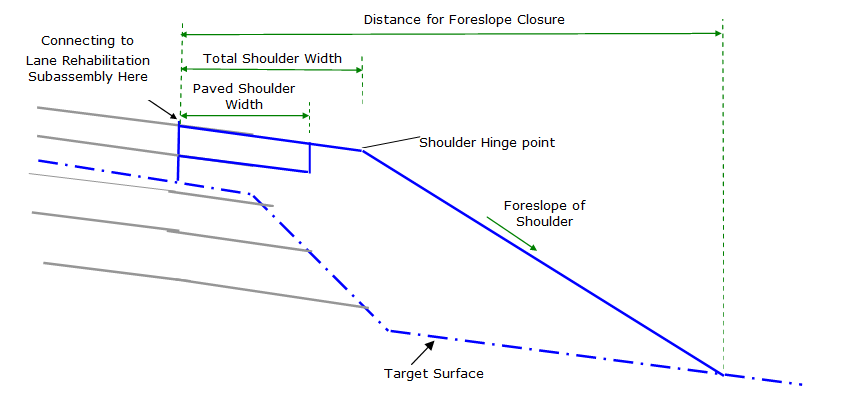
Option B
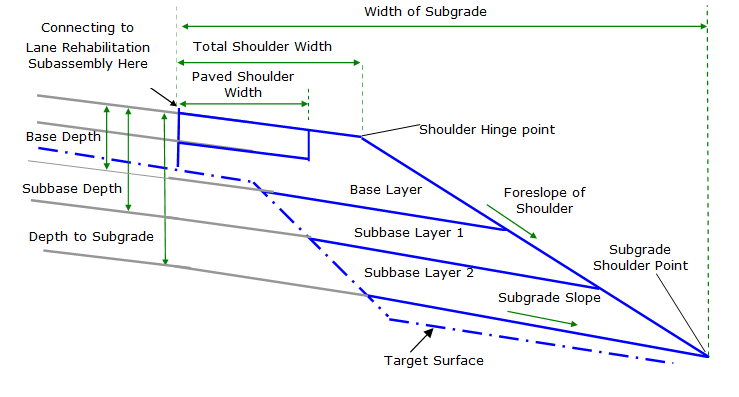
Option C
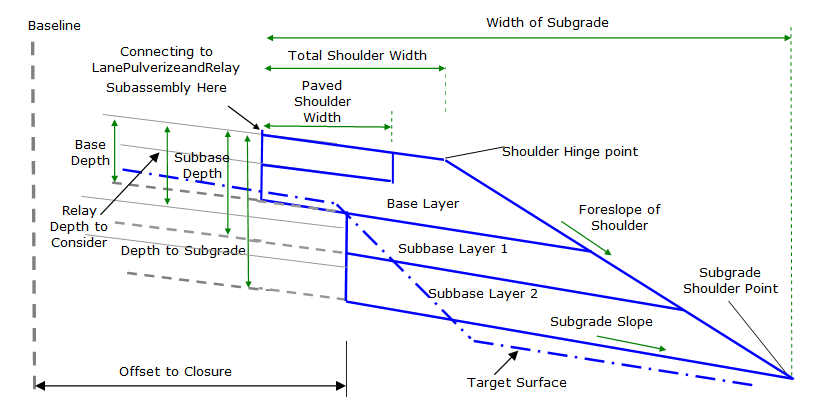
 Behavior
Behavior
Widths and depths
This subassembly models various shoulder rehabilitation options used by the Wisconsin Department of Transportation. The input parameter descriptions describe some of the behavior of the subassembly, and beyond that, diagrams and example Input parameters are used to best describe the behavior of the subassembly.
The shoulder is inserted using widths and depth parameters provided. The Total Top Shoulder Width parameter must be greater than or equal to Paved Shoulder Width value. If the input for Total Shoulder Width is less than the input for Paved Shoulder Width, than the Total Shoulder Width input value will be set equal to the Paved Shoulder Width value.
Various base course layer depths can be defined however different parameters are considered when the Depth to Subgrade is zero. This value defines the depth to the bottom of the lowest base course layer. If the Base Depth entered is greater than the Subbase Depth entered, then Subbase Depth is equal to the Base Depth. If the Depth to Subgrade input is less than either the Base Depth or the Subbase Depth, then the Depth to Subgrade will be equal to the greater of the two values (unless Depth to Subgrade is zero, in which case it will stay zero). User has the option of setting Parameter References for Base and Subbase course depths, as well as the Depth to the Subgrade Surface using the depths of these same surfaces output from the adjacent subassemblies. User also has the option of specifying the paved and unpaved shoulder slope values by setting a parameter reference to the pavement slope on an adjacent lane. In order to use this option, the Paved Shoulder SE Method and/or UnPaved Shoulder SE Method parameter must be set to Fixed Slope.
Methods of determining paved and unpaved shoulder slopes
The behavior described here for controlling the slope of the paved and unpaved portion of the top of shoulder, works with all Options.
When a Fixed Slope is used in the Paved Shoulder SE Method and/or UnPaved Shoulder SE Method, the following logic is followed for calculating the slope of the paved and unpaved portions of the shoulder:
- When Paved Shoulder SE Method and/or UnPaved Shoulder SE Method are set to Fixed Slope, the slopes of the paved and unpaved portion of the shoulder are controlled by the inputs for the Fixed Paved Shoulder Slope and/or Fixed UnPaved Shoulder Slope parameters, unless a parameter reference is set for those two values.If a parameter reference is set for Fixed Paved Shoulder Slope and/or Fixed UnPaved Shoulder Slope, then the adjacent lane's pavement slope (read in by parameter reference) is used to override the Fixed Slope values.
-
If input values for the Fixed Paved Shoulder Slope and/or Fixed UnPaved Shoulder Slope parameters are greater than the "calculated adjacent lane slope" then Fixed Paved Shoulder Slope and/or Fixed UnPaved Shoulder Slope are overridden and the new values are set equal to "calculated adjacent lane slope". Method to Obtain Slope of Adjacent Lane for Rollover Calculation input parameter is used to determine "calculated adjacent lane slope" value. This logic ensures that travel lanes' cross slopes are not steeper than shoulder cross slopes in superelevated sections.
Rollover consideration
When Paved Shoulder SE Method is set to Fixed Slope, the paved shoulder slope value can be overridden by Rollover considerations. If the algebraic difference between Fixed Paved Shoulder Slope value and "calculated adjacent lane slope" exceeds the Max Rollover Rate then the Fixed Paved Shoulder Slope value will be overridden and paved shoulder slope is calculated so that the algebraic difference between paved shoulder slope value and "calculated adjacent lane slope" equals the Max Rollover Rate Method to Obtain Slope of Adjacent Lane for Rollover Calculation input parameter is used to determine "calculated adjacent lane slope" value. Example #1 rollover exceeded scenario:
- Paved Shoulder SE Method = Fixed Slope
- UnPaved Shoulder SE Method = Match Paved Shoulder Slope
- Fixed Paved Shoulder Slope = -4.0%
- Method to Obtain Slope of Adjacent Lane for Rollover Calculation = Use Outside Lane SE
- Baseline Outside Lane SE = 5.0%
-
Max Rollover Rate = 7.0%
In example #1 scenario the Fixed Paved Shoulder Slope value is overridden by Rollover considerations because the algebraic difference between Fixed Paved Shoulder Slope value and "calculated adjacent lane slope" exceeds the Max Rollover Rate. (5% -(-4%)) = 9%; 9% > 7%. A new paved shoulder slope will be calculated by the subassembly to be (Calculated Adjacent Lane Slope) – (Max Rollover Rate) = 5% - 7% = -2%. Unpaved shoulder slope will also = -2% because it must match the paved shoulder slope.
When UnPaved Shoulder SE Method is set to Fixed Slope, the Fixed UnPaved Shoulder Slope can be overridden by Rollover considerations. After paved shoulder slope value is determined, if the algebraic difference between paved shoulder slope value and Fixed UnPaved Shoulder Slope exceeds the Max Rollover Rate then the Fixed UnPaved Shoulder Slope value will be overridden and unpaved shoulder slope value is calculated so that the algebraic difference between paved shoulder slope value and unpaved shoulder slope equals the Max Rollover Rate. Example #2 rollover exceeded scenario (integral shoulder pavement):
- Paved Shoulder SE Method = Outside Lane SE
- UnPaved Shoulder SE Method = Fixed Slope
- Baseline Outside Lane SE = 6.0%
- Fixed UnPaved Shoulder Slope = -4.0%
-
Max Rollover Rate = 7.0%
In example #2 scenario the Fixed UnPaved Shoulder Slope value is overridden by Rollover considerations because the algebraic difference between Fixed UnPaved Shoulder Slope value and paved shoulder slope value exceeds the Max Rollover Rate. (6% -(-4%)) = 10%; 10% > 7%.A new unpaved shoulder slope will be calculated by the subassembly to be (paved shoulder slope) – (Max Rollover Rate) = 6% - 7% = -1%.
When Paved Shoulder SE Method and/or UnPaved Shoulder SE Method are set to Use Inside Shoulder SE or Use Outside Shoulder SE, the slopes of the paved and unpaved portion of the shoulder are controlled by the shoulder SE rates defined for the baseline alignment. If no shoulder SE rates are defined for the baseline alignment, slopes values are defined by the Fixed Paved Shoulder Slope and Fixed UnPaved Shoulder Slope inputs.
When Paved Shoulder SE Method and/or UnPaved Shoulder SE Method are set to Use Inside Lane SE or Use Outside Lane SE, the slopes of the paved and unpaved portion of the shoulder are controlled by the lane SE rates defined for the baseline alignment. If no lane SE rates are defined for the baseline alignment, slopes values are defined by the Fixed Paved Shoulder Slope and Fixed UnPaved Shoulder Slope inputs.
When Match Paved Shoulder Slope is used for UnPaved Shoulder SE Method the slope of the Unpaved portion of shoulder will always be set equal to the Paved Shoulder Slope (as determined by Paved Shoulder SE Method and accompanying logic).
When Match Paved Shoulder Slope is used for UnPaved Shoulder SE Method the slope of the Unpaved portion of shoulder will always be set equal to the Paved Shoulder Slope (as determined by Paved Shoulder SE Method and accompanying logic).
Subgrade slope
When subgrade links are inserted, subgrade slope is controlled by the Subgrade SE Method parameter. User has the option of entering a fixed slope to be used, following the insertion side Outside Lane SE defined for the baseline alignment, following the insertion side Inside Lane SE defined for the baseline alignment, using the Outside Lane SE defined for the baseline on the opposite side which is then multiplied by -1.0, using the Inside Lane SE defined for the baseline on the opposite side which is then multiplied by -1.0, matching paved shoulder slope as determined by Paved Shoulder SE Method, or matching unpaved shoulder slope as determined by UnPaved Shoulder SE Method. When Subgrade SE Method is set to Fixed Slope, this slope can be controlled using a Parameter Reference that sets the slope equal to that of the subgrade surface of an adjacent lane.In all situations, the slopes of all base course surfaces will follow the slope of the subgrade surface.
It is possible that the subassembly inputs create a situation in which the subgrade surface intersects with shoulder top surface prior to the shoulder hinge point, if the shoulder is wide enough. In this case a message will be written to the event viewer, the subgrade slope will hold it's value, and the Paved Shoulder Slope and UnPaved Shoulder Slope will be adjusted to intersect the subgrade link at the width determined by Total Shoulder Width. This concept is shown below:
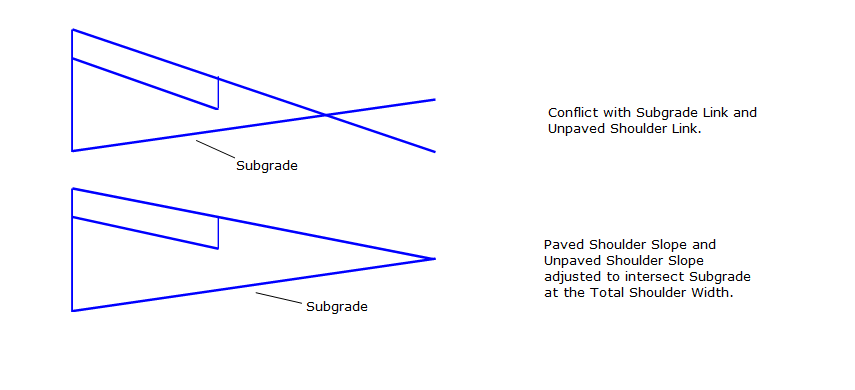
Constant width of subgrade
In all cases, except when Depth to Subgrade is 0, the distance from the Shoulder Hinge Point to the Subgrade Shoulder point is computed by the subassembly as follows:
If Maintain Constant Width is set to ‘False', the Foreslope of Shoulder input will be used to determine shoulder foreslope during superelevated sections and the Width of Subgrade will vary.
If Maintain Constant Width is set to ‘True', then the Width of Subgrade, measured horizontally from the attachment point to the subgrade shoulder point, is computed based on Subgrade Slope For Constant Width Calc, Paved Shoulder Slope For Constant Width Calc, UnPaved Shoulder Slope For Constant Width Calc, Paved Shoulder Width, Total Top Shoulder Width, Depth to Subgrade, and Foreslope of Shoulder.The Width of Subgrade is then held constant through superelevated sections, and the Foreslope of the Shoulder parameter is ignored in these sections.
If targets are established for Paved Shoulder Width or Total Top Shoulder Width then the width values retrieved from those targets will be used in the constant Width of Subgrade calculations and the user inputs for Paved Shoulder Width and Total Top Shoulder Width are ignored.
The calculation and corresponding reference diagram used to determine constant Width of Subgrade are shown here:
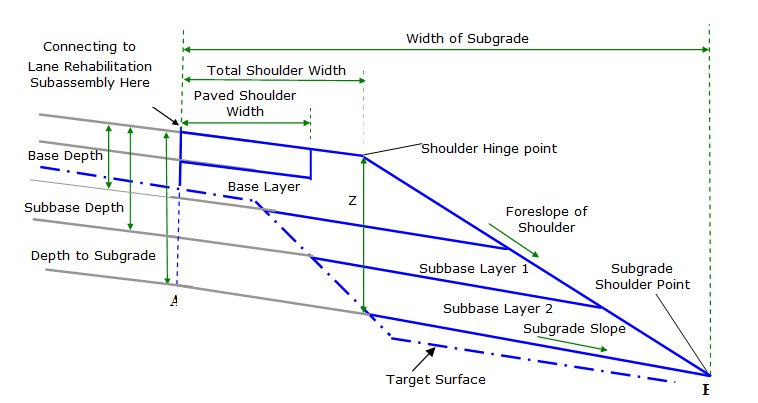
To compute constant width of subgrade
- Unpaved Shoulder Width = (Total Shoulder Width) – (Paved Shoulder Width)
- Z Value = (Depth to Subgrade) + ((UnPaved Shoulder Width * UnPaved Shoulder Slope For Constant Width Calc) + (Paved Shoulder Width * Paved Shoulder Slope For Constant Width Calc) – (Subgrade Slope For Constant Width Calc * Total Shoulder Width))
- Width of Subgrade (Width From Point A to Point B) =
-
(Total Shoulder Width) + (-1) * ((Z Value) / (Foreslope of Shoulder – Subgrade Slope For Constant Width Calc))
Example constant width of subgrade calculation
For the following condtions:
- Paved Shoulder Width = 4 ft
- Total Top Shoulder Width = 10 ft
- Paved Shoulder Slope For Constant Width Calc = -4%
- UnPaved Shoulder Slope For Constant Width Calc = -4%
- Subgrade Slope For Constant Width Calc = -2%
- Foreslope of Shoulder = 4:1
- Depth to Subgrade = 2 ft.
-
No targets set for Paved Shoulder Width or Total Top Shoulder Width.
Z = (2) + ((6*(-0.04) + (4*(-0.04)) – ((-0.02)*10)
= (2) + ((-.24) + (-.16)) – (-.2)
= 2 - .4 + .2
Z = 1.8
Width of Subgrade= (10) + (-1) * (1.8)/((-.25) – (-.02))
= (10) + (-1) * (1.8)/(-.23)
= (10) + (-1)*(-7.826)
Width of Subgrade= 17.826
How Option A works
This option is normally used when WisDOT's LnRehab subassembly is inserted adjacently with Overlay Only and No Cutout. This is not a requirement, but a recommendation for the user.
Two different scenarios exist with Option A. In both scenarios, Base Depth, Subbase Depth and Depth to Subgrade equal 0.0. Option A is only modeled when Depth to Subgrade is 0.0.
In both scenarios shown, the behavior of the paved and unpaved portion of the shoulder is the same as that described previously. From the Shoulder Hinge Point one of two things happen:
- When the parameter Closure Method When Depth to Subgrade is 0 is equal to Distance, a link is inserted from the Shoulder Hinge Point downward to the intersection of the Target Surface at the Distance defined by the input parameter Distance for Foreslope Closure. This distance is measured from the attachment point. If no intersection is found with a downward slope, subassembly is not inserted and an error is logged.
-
When the parameter Closure Method When Depth to Subgrade is 0 is equal to Use Foreslope of Shoulder, a link is inserted from the Shoulder Hinge Point downward with a slope equal to the Foreslope of Shoulder input parameter, to the intersection of the Target Surface. If no intersection is found with a downward slope, subassembly is not inserted and an error is logged.
An essentially vertical link is inserted from the attachment point down to the intersection with the Target Surface. From this point, links are inserted, following the Target Surface to the Intersection with Target Surface point, as shown in the diagram below.

Pertinent parameters set to accomplish the example shown on the left side include:
Side = Left
Pavement Height = 6.0
Base Depth = 0.0
Subbase Depth = 0.0
Depth to Subgrade = 0.0
Paved Shoulder Width = 2.0
Total Top Shoulder Width = 4.0
Foreslope of Shoulder = Input will not be used because closure method is Distance; the Foreslope of Shoulder will vary depending on the distance to the daylight point.
Closure Method When Depth to Subgrade is 0 = Distance
Distance to Foreslope Closure = 25
Pertinent parameters set to accomplish the example shown on the right side include:
Side = Right
Pavement Height = 6.0
Base Depth = 0.0
Subbase Depth = 0.0
Depth to Subgrade = 0.0
Paved Shoulder Width = 2.0
Total Top Shoulder Width = 4.0
Foreslope of Shoulder = 4:1
Closure Method When Depth to Subgrade is 0 = Use Foreslope of Shoulder
Info: If Closure Method When Depth to Subgrade is 0 = Use Foreslope of Shoulder, the Distance To Foreslope Closure is not used. Since all base course depths are set to 0.0 only the top of the shoulder is modeled.
How Option B works
This option is normally used when WisDOT's LnRehab subassembly is inserted adjacently.It is used in situations where base, subbase and the subgrade surface will be modeled.A daylighting subassembly is inserted after to complete the section.
In the example shown below, Depth to Subgrade > 0.0 and Closure Method When Depth to Subgrade > 0 is equal to Close Back to Target Surface. The behavior of the paved and unpaved portion of the shoulder is the same as that described previously.
From the Shoulder Hinge Point, a link is inserted downward using the Foreslope of Shoulder slope to the subgrade shoulder point, unless Maintain Constant Width is set to True in which case the slope of the shoulder foreslope will be controlled by the constant Width of Subgrade computed as described earlier.
Base Depth, Subbase Depth and Depth to Subgrade inputs are used to define the various base layers as shown in the diagram. All measurements are taken from the attachment point down.
With Closure Method When Depth to Subgrade > 0 is set to Close Back to Target Surface, base and subbase surface links, as well as the subgrade surface link that ends at the Subgrade Shoulder Point, are extended from the Foreslope of the Shoulder link back to the target surface.The slope of the subgrade surface link is controlled by the Subgrade SE Method input parameter, and all base/subbase course surfaces will have slopes that follow the subgrade surface slope.

Pertinent Parameters set to accomplish the example shown example include:
Pavement Height = 6.0
Base Depth = 1.0
Subbase Depth = 1.5
Depth to Subgrade = 2.0
Paved Shoulder Width = 2.0
Total Top Shoulder Width = 4.0
Foreslope of Shoulder = 4:1
Closure Method When Depth to Subgrade >0 = Close Back to Target Surface
Target Surface set to Existing Ground Surface.
Values defining Slopes and superelevation methods to use will also be set but are not unique to this example, therefore are not shown.
The inputs Offset to Closure and Relay Depth to Consider will be ignored when Closure Method When Depth to Subgrade > 0 is set to Close Back to Target Surface. All base course and subgrade links extend back to their intersection with the named Target Surface, not a defined offset from the baseline alignment.
How Option C works
This option is normally used when a LnPulvRelOne or LnPulvRelBoth subassembly is inserted adjacently. It is used in situations where base, subbase and the subgrade surface will be modeled. A daylighting subassembly is inserted after to complete the section.
In the example shown below, Depth to Subgrade > 0.0 and Closure Method When Depth to Subgrade > 0 is equal to Close at Offset. The behavior of the paved and unpaved portion of the shoulder is the same as that described previously.
From the Shoulder Hinge Point, a link is inserted downward using the Foreslope of Shoulder slope to the subgrade shoulder point, unless Maintain Constant Width is set to True in which case the slope of the shoulder foreslope will be controlled by the constant Width of Subgrade computed as described earlier.
Base Depth, Subbase Depth and Depth to Subgrade inputs are used to define the various base layers as shown in the diagram.All measurements are taken from the attachment point down.
With Closure Method When Depth to Subgrade > 0 is set to Close at Offset, base and subbase surface links, as well as the subgrade surface link that ends at the Subgrade Shoulder Point, are extended from the Foreslope of the Shoulder link back to a distance defined by the Offset to Closure input parameter.The offset is measured from the baseline.The slope of the subgrade surface link is controlled by the Subgrade SE Method input parameter, and all base/subbase course surfaces will have slopes that follow the subgrade surface slope.
A link extends from the end of the subgrade link to a depth defined by Relay Depth to Consider or Base Depth, whichever is less.This depth is measured from the top of the shoulder down.A second link extends back from the Relay Depth to Consider, following the same slope as the other base course layers, to the attachment point offset.

Pertinent Parameters set to accomplish the example shown above include:
Pavement Height = 6 inches
Base Depth = 1.0
Subbase Depth = 1.5
Depth to Subgrade = 2.0
Paved Shoulder Width = 2.0
Total Top Shoulder Width = 4.0
Foreslope of Shoulder = 4:1
Closure Method When Depth to Subgrade > 0 = Close at Offset
Offset to Closure = 15.0
Relay Depth to Consider = 10"
Remember that a link extends from the end of the subgrade link to a depth defined by Relay Depth to Consider or Base Depth, whichever is less. This depth is measured from the top of the shoulder down. In this example, Relay Depth to Consider is less than the Base Depth, therefore the link from the end of the subgrade link extends up to the depth defined by the Relay Depth to Consider. A second link extends back from the Relay Depth to Consider, following the same slope as the other base course layers, to the attachment point offset.
 Attachment & layout mode operation
Attachment & layout mode operation
The attachment point is at the inside edge of the shoulder on the finished grade.
In layout mode, this subassembly displays the links comprising a shoulder for a normal crown roadway situation, using default top shoulder slopes and subgrade surface slopes.
 Input parameters
Input parameters
Info: All dimensions are in feet unless otherwise noted. All slopes are in run-over-rise form (for example, 4:1) unless indicated as a percent slope with a "%" sign.
| Parameter | Description | Type | Default |
|---|---|---|---|
| Side | Specifies which side to place the subassembly. | Left/Right | Right |
| Maintain Constant Width | Specifies whether the foreslope will vary to maintain a constant Width of Subgrade. If set to False, the Width of Subgrade will vary and the foreslope slope is maintained; foreslope slope value is determined by user input in the Foreslope of Shoulder input parameter. If set to True the Width of Subgrade value is maintained and the foreslope slope will vary; method for calculating Width of Subgrade is described in the Behavior Section. This input is ignored when Depth to Subgrade is set equal to 0. | True / False | True |
| Pavement Height (inches) | Depth of Pavement measured from the attachment point down. | Numeric, Positive | 6.0 inches |
| Base Depth | Distance to the bottom of the first base course layer. This measurement is taken from the top of the pavement. If there is no base course layer, a zero depth should be specified. | Numeric, Positive | 0.0 ft. |
| Subbase Depth | Distance to the bottom of the second base course layer. This measurement is taken from the top of the pavement. If there is no second base course layer, a zero depth should be used. | Numeric, Positive | 0.0 ft. |
| Depth to Subgrade | Distance to the top of the Subgrade Surface. This measurement is taken from the top of the pavement. The depth specified here should be the depth to the bottom of the last base/subbase course layer. | Numeric, Positive | 2.0 ft. |
| Paved Shoulder Width | Width of the paved portion of the Shoulder. | Numeric, Positive | 8.0 ft. |
| Total Top Shoulder Width | Total width of the shoulder from the attachment point to the shoulder hinge point. Total Top Shoulder Width must be greater than or equal to Paved Shoulder width. | Numeric, Positive | 10.0 ft. |
| Paved Shoulder SE Method | Specifies whether the top surface of the paved shoulder should use SE rates defined for the baseline alignment if it exists, or a Fixed Value. |
List of options: a.) Fixed Slope, b.) Use Outside Lane SE c.) Use Inside Lane SE d.) Use Outside Shoulder SE, e.) Use Inside Shoulder SE |
Use Outside Shoulder SE |
| UnPaved Shoulder SE Method | Specifies whether the top surface of the unpaved shoulder should use SE rates defined for the baseline alignment if it exists, or a Fixed Value. If Match Paved Shoulder Slope is used, all other considerations are ignored and the slope of the UnPaved top surface of the shoulder will equal the slope of the Paved portion as determined by Paved Shoulder SE Method. |
List of options: a.) Fixed Slope, b.) Use Outside Lane SE c.) Use Inside Lane SE d.) Use Outside Shoulder SE, e.) Use Inside Shoulder SE, f.) Match Paved Shoulder Slope |
Match Paved Shoulder Slope |
| Fixed Paved Shoulder Slope | Cross slope of the paved shoulder surface. This value is used if Paved Shoulder SE Method is set to Fixed Slope, or if superelevation is not defined for the baseline alignment. Value can be set using a parameter reference. | Slope | -4.0% |
| Fixed UnPaved Shoulder Slope | Cross slope of the UnPaved shoulder surface. This value is used in if UnPaved Shoulder SE Method is set to Fixed Slope, or if superelevation is not defined for the baseline alignment. Value can be set using a parameter reference. | Slope | -4.0% |
| Foreslope of Shoulder | Slope of the Foreslope of the shoulder which extends from the Shoulder Hinge Point to the Subgrade Shoulder Point. If Maintain Constant Width set to ‘False', the Foreslope specified here is maintained in superelevated sections. If Maintain Constant Width is set "True" then this value will be used to calculate the Width of Subgrade value but it will not be the foreslope slope in superelevated sections. | Slope, Positive | 4:1 |
| Subgrade SE Method | Specifies the method used to determine the slope of the subgrade surface. Use the Opposite Side SE Multiplied by -1.0, results in the subgrade slope being equal to Superelevation Slope defined for the baseline on the side opposite the insertion side, multiplied by -1.0. If Match Paved Shoulder Slope or Match UnPaved Shoulder Slope is selected, the Subgrade will be parallel to the top of shoulder surface as determined by Paved Shoulder SE Method or UnPaved Shoulder SE Method. |
String, Combo List of options: a.) Use Outside Lane SE, b.) Use Inside Lane SE, c.) Use the Opposite Side Outside Lane SE Multiplied by -1.0, d.) Use the Opposite Side Inside Lane SE Multiplied by -1.0, e.) Fixed Slope, f.)Match Paved Shoulder Slope, g.) Match UnPaved Shoulder Slope |
Use Outside Lane SE |
| Fixed Subgrade Slope | Fixed cross slope of the subgrade surface. This value is used if Fixed Slope is selected as the Subgrade SE Method or when superelevation is not specified for the baseline alignment. | Slope | -2% |
| Max Rollover Rate | Value is used to limit the maximum algebraic difference between the slope of the Paved or Unpaved Shoulder surfaces and the slope of the adjacent travel lane, also is used to limit the algebraic difference between the slope of the Paved Shoulder and UnPaved Shoulder surfaces. Rollover based shoulder rotation in superelevated sections is described in the Behavior section. | Slope | 7.0% |
| Method to Obtain Slope of Adjacent Lane for Rollover Calculation | Specifies the method to use to determine the slope of the adjacent lane. When using Outside or Inside Lane SE of the insertion side, or the opposite side SE multiplied by -1.0, the SE rate that is used is that defined for the baseline. Fixed Slope will automatically be used when no baseline SE is defined. |
String, Combo List of options: a.) Use Outside Lane SE, b.) Use Inside Lane SE, c.) Use the Opposite Side Outside Lane SE Multiplied by -1.0, d.) Use the Opposite Side Inside Lane SE Multiplied by -1.0, e.) Fixed Slope |
Fixed Slope |
| Fixed Slope of Adjacent Lane for Rollover Calculation | Slope value to be used when calculating rollover when Method to Obtain Slope of Adjacent Lane is set to Fixed Slope. Value can (and should) be set by a parameter reference. | Slope | -2% |
| Closure Method When Depth to Subgrade is 0 | This parameter is only used when Depth to Subgrade = 0.0 (either the inputted value or the value obtained through a parameter reference). Parameter defines the method to use for the extension of the Foreslope of Shoulder link in the Option A type conditions (also described in Behavior section in Example 1). When set to Use Foreslope of Shoulder, the top of the shoulder is extended from the end shoulder hinge point using the Foreslope of Shoulder input parameter value to its intersection with the Target Surface. When Distance is specified, the foreslope link will extend from the shoulder hinge point to the distance specified in the Distance to Foreslope Intersection with Target Surface value. This input is ignored if Depth to Subgrade > 0.0. |
List of options: a.) Use Foreslope of Shoulder, b.) Distance |
Use Foreslope of Shoulder |
| Distance to Foreslope Closure | Specifies the distance used to extend the Foreslope of Shoulder link to its intersection with the Target Surface when Closure Method When Depth to Subgrade is 0 is set to Distance. Distance is measured from the Attachment Point. | Numeric, positive | 15.0 ft. |
| Closure Method When Depth to Subgrade > 0 | This parameter is only used when Depth to Subgrade > 0.0 (either the inputted value or the value obtained through a parameter reference). Defines the method to close the Base Layer, Subbase Layer 1, and Subbase Layer 2 shapes. When set to Close Back to Target, all base course links and the subgrade link will be extended back towards the baseline to the intersection with the Target Surface, using slopes defined using the Subgrade SE Method input. This is shown in the Option B graphic. When Close at Offset is specified, all base course links and the subgrade link are extended back towards the baseline to the offset defined by the Offset to Closure parameter, again using slopes defined using the Subgrade SE Method input. This is shown in the Option C graphic. |
List of Options: a.) Close Back to Target Surface, b.) Close at Offset |
Close Back to Target Surface |
| Offset to Closure | Parameter is only used when Closure Method is set to Close at Offset. Specifies the offset (from the baseline) that is used to extend base course and subgrade links back to. A negative value indicates an offset to the left of the baseline. This value can be set by a parameter reference. From the subgrade link at the offset defined here, an essentially vertical link is inserted upward to an elevation defined by the Base Depth or the Relay Depth to Consider inputs, whichever is less, but not 0.0. From the end of the essentially vertical link, a final link is extended back towards the baseline, to the offset of the attachment point. This last link uses the same slope as the base course and subgrade links. From this point, another link is inserted, ending at the attachment point. | Numeric | 12.0 ft. |
| Relay Depth to Consider | Specifies a depth to compare with Base Depth for shape closure when Closure Method is set to Close at Offset. Depth can be set by a parameter reference. Measurement is taken from the top of the pavement at the attachment point downward. In areas with no relay depth to consider, use a Relay Depth to Consider = 0.0. | Numeric, positive | 10 inches |
| Subgrade Slope For Constant Width Calc | Slope value of the Subgrade surface during Normal Crown situations. This value is used for the sole purpose of computing a constant subgrade width value, it has no effect on the actual subgrade surface slope. | Slope | -2% |
| Paved Shoulder Slope For Constant Width Calc | Slope value of the Paved Shoulder surface during Normal Crown situations. This value is used for the sole purpose of computing a constant subgrade width value, it has no effect on the actual Paved Shoulder surface slope. | Slope | -4% |
| UnPaved Shoulder Slope For Constant Width Calc | Slope value of the UnPaved Shoulder surface during Normal Crown situations. This value is used for the sole purpose of computing a constant subgrade width value, it has no effect on the actual UnPaved Shoulder surface slope. | Slope | -4% |
 Target parameters
Target parameters
This section lists the parameters in this subassembly that can be mapped to one or more target objects, such as a surface, alignment, or profile object in a drawing.
| Parameter | Description | Status |
|---|---|---|
| Target Surface | Name of Surface used for Daylighting. The following object types can be used as targets for specifying the width: alignments, polylines, feature lines, or survey features. | Required |
| Paved Shoulder Width | Object that defines the edge of the paved portion of the shoulder. The following object types can be used as targets for specifying the width: alignments, polylines, feature lines, or survey features. | Optional |
| Total Top Shoulder Width | Object that defines the shoulder hinge point. The following object types can be used as targets for specifying the width: alignments, polylines, feature lines, or survey features. | Optional |
| Distance to Foreslope Closure Intersection with Target Surface | Object that defines the offset used to extend the foreslope link to its intersection with the Target Surface. Used only when Depth to Subgrade = 0 and Closure Method When Depth to Subgrade is 0 = Distance. The following object types can be used as targets for specifying the width: alignments, polylines, feature lines, or survey features. | Optional |
| Offset to Closure | Object that defines the offset when Depth to Subgrade is > 0 and Closure Method When Depth to Subgrade > 0 = Close at Offset. The following object types can be used as targets for specifying the width: alignments, polylines, feature lines, or survey features. | Optional |
 Output parameters
Output parameters
| Parameter | Description | Type |
|---|---|---|
| Shoulder Foreslope | Slope of the link from the hinge point to the subgrade shoulder point. | Slope |
 Coding diagram
Coding diagram
Option A

Option B - Point Codes
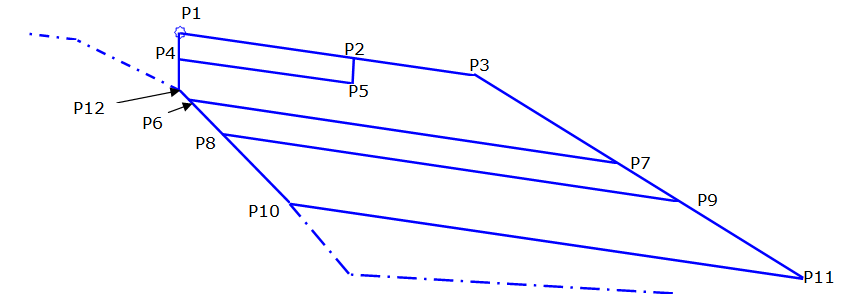
Option B - Link and Shape Codes

Option C - Point and Shape Codes
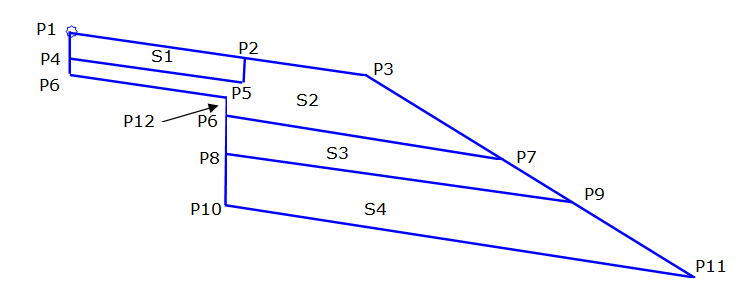
Option C - Link Codes

 Point, Link, and Shape codes
Point, Link, and Shape codes
| Point/Link/Shape | Codes | Description |
|---|---|---|
| P2 | EPS | Edge of paved shoulder, finish grade |
| P3 | ES_Unpaved | Edge of gravel Shoulder; outer edge of unpaved portions of shoulder on finished grade. |
| P5 | EPS_Base | Edge of paved shoulder on the Base Layer |
| P7 | ES_Base1 | Edge of shoulder on Base1 Layer |
| P9 | ES_Base2 | Edge of shoulder on Base2 Layer |
| P11 |
SGSP Daylight_Sub |
Subgrade Shoulder Point or Daylight Point |
| L1 |
Top PaveShld |
Finish grade of the shoulder |
| L3 | Base | |
| L4 | Base | |
| L5 |
Top Base1 |
Top of the first base layer; surface always exists |
| L6 |
Top Base1 |
|
| L7 | Base1 | Top of the second base course layer. This is an optional layer. |
| L8 | Base2 | Top of the Subbase Layer |
| L9 |
Datum Subbase SUBG |
Top of the Subgrade between Subgrade Shoulder points, and the FINGRND surface |
| L10 |
Top Base2 |
|
| L11 |
Top Base2 |
|
| L12, L13 | No Codes | Follows the Target Surface |
| L14, L15 | No Codes | No codes assigned |
| S1 | Pave1_Shoulder | |
| S2 | Base1 | |
| S3 | Base2 | |
| S4 | Subbase | lorem ipsum |